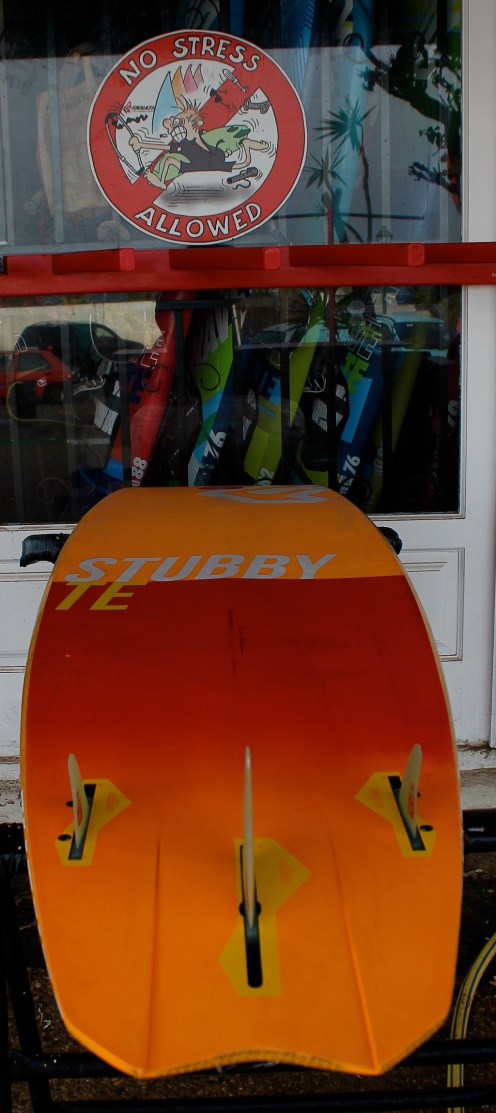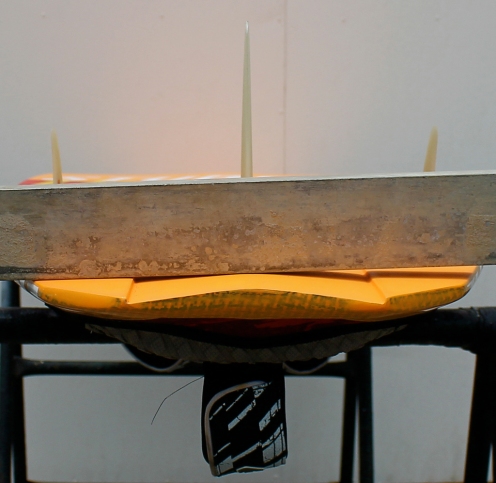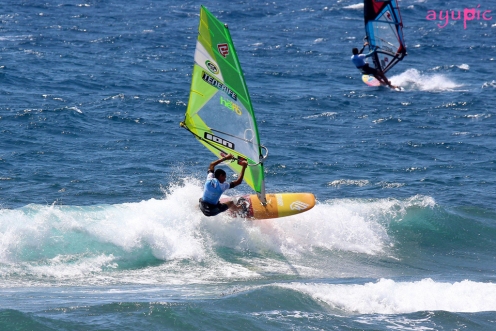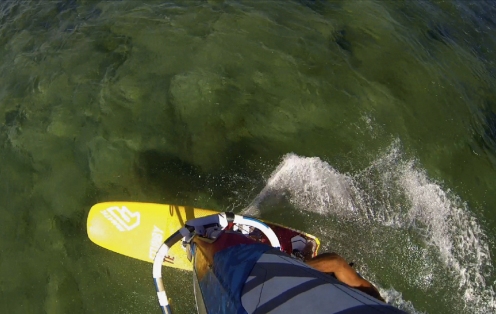STUBBY 2016
The Stubby, Short and radical.
Is this the beginning of the new school?
The volume distribution makes for an interesting deck shape, the thickest section is around the front foot strap. In windsurfing we have our feet in the straps, so it is nice to have the front strap just behind the centre of the board. The mast foot just in front of the centre point, means by putting pressure through the mast foot is like stepping forwards in surfing to trim the board. So on this board you have the option to place the mast foot at 116 cm from the tail, a more traditional position would be round 120/125 cm. The back strap is right on the tail, plus the spread is much wider at 59 cm. Very surf board style, back foot front foot riding.
We need thin rails at the back, so no volume and no weight in the nose, so again no volume. The wide tail and nose really does help to give what I call active volume, the moment the board just has a little forward momentum it lifts up.
The board is short, 212 cm/ 6′ 11 1/2” long and 55 cm 21 1/2” wide. This means that the board can have a flatter rocker line, especially when the stance area is so much on the back.
The entry rocker is very subtle which makes it look as if there is very little nose rocker.
When I move the straight edge back to the riding section of the board you can see that the nose will be more than enough out of the water. The tail rocker is very gentle with almost no kick.
The tail is wide, so even a small amount of ‘V’ is noticed.
The ‘V’ in the tail is extreme, especially in the channel. The overall ‘V’ will make it very easy to roll from one edge to the other as it is quite round. This amount of ‘V’ is normally seen just in front of the fins but on this board the deepest part of the ‘V’ is right on the tail. So this is where you will be changing rails, as I always say “back foot command.”
This board is for planing, carving, slashing, pivoting, sliding. Just imagine something you would like to do on the wave and it will help you achieve it, of course you have to stay on it as it reacts so fast. (I can not do a lot of the new school moves but I do like to pick a section on a wave and say I would like to do this.)
So on the water for more testing.
Yes this board turns, very much back foot command and then drive with the front foot/rig. Due to the wide tail you can really turn this board tight and keep the speed, climbing the wave vertically for that snappy cut back. The feeling very much reminds me of the first quad which had quite a wide tail but was much slower due to the tail kick. The ‘V’ in the tail really does help to change rails with the back foot, this is especially noticeable in the top turn.
The wide nose really does help to give you lift, especially when it comes to white water. Coming out of a bottom turn and finding the wave has or is going to close, don’t worry. Just go vertical and hit it. The nose is short so it is important to get your fore and aft trim accurate. Leaning to far forwards, for example after a top turn will bury the nose but it does pop right back up.
“( Settings:- mast foot back, straps forward, thruster fins back and centre fin Forwards and of cause my 3.7m Hero.)” These are always the settings I use when I first go on a board. As expected it is very loose.
So back to the beach to change the positions, closer to the measurements I use on my Free Wave 86L. ( Which is exactly the settings above on that board.)
Side fins right at the back of the box, which is one parameter which is the same. Centre fin at the FW distance from those. So the centre fin is much closer to the tail. Back strap as far forward as it can go. Then the front strap as near to the measurement on the FW, which is right back but still further apart. Interesting as to get the same distance from the mast foot to the front strap, I actually moved the MF forwards a little. This helped to compensate for moving the front straps back.
This made the stance feel a lot better and for my light weight, being more on the tail did give more control over the wide tail. The mast being a bit further forwards did make the board ride a bit flatter. The centre fin being further back as well made the board less nervous, so I could drive harder in the bottom turn. My conclusion is, do play around with the settings. Even though they are only minor adjustments, you can really fine tune the board for different wave and wind conditions.
I do sail a lot in light winds with a small Sail. Once you find the sweet spot on the board, standing around, tacking, getting in the straps to ride the wave is not a problem. Due to the early planing characteristics of this board, once you are on the wave it is so much fun. Have the straps quite big though, as you will have to get out of them quite quick once you finish the wave if there is little wind. (I do wonder how the SUP stubby is with a sail? Strapless in light winds could always be an option.) Or maybe even better a 100L+ Stubby?
I have said this board is a planing machine. Well, all boards plane but the feeling on the Stubby is very different. When you have the rig balanced it feels more like a kite board. In the air you really do not feel the board. Changing your body position from rail to rail really does make this board turn, more commitment, more fun.
The fore and aft trim is quite delicate. The balance really is over the front foot strap. Standing stationary my front foot is just by the mast or just behind and the back foot, directly behind the front strap. Planing, your orientation is directly between the strap. Front leg strait, back leg bent brings your body to far back and slows the board down, be careful when trying to get planing. Front leg bent, back leg straight brings your body forwards and rocks the board onto the entry rocker. Makes the board stick, be careful going into a lull. It also releases the tail, if you want rotation just bring your body forward of the front strap and round you go. Automatic! You really do not have to go so far forwards to release the tail, normally you are thinking of going over the mast foot. So think about it if you find you are getting a bit of spinout.
So what is this board for?
Early planing and fast acceleration. Hitting any white water with ease. Fast rotation on the water and in the air. Tight radical turns. Watching the pros use it in Pozo, Tenerife, Klimoller and Sylt, you have to say it is for cross onshore conditions but it is more about the characteristics I have listed. It will tend to be for smaller waves but what the pros call small and we call small are two completely different statements.
Could this board be an only board for me? Well yes,. But for the conditions I enjoy sailing in the most, I think I would go for the 88L.















